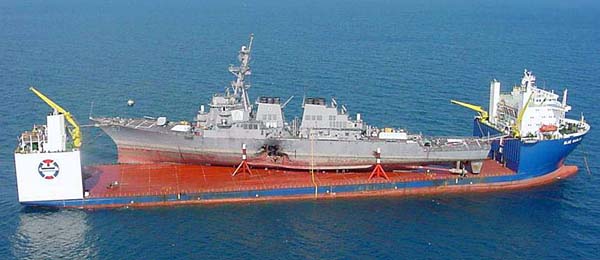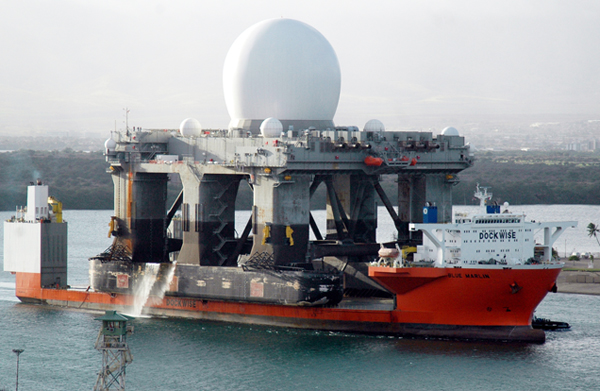Semi-Submersible Ships
Today, semi-submersible ships. The University of Houston's College of Engineering presents this series about the machines that make our civilization run, and the people whose ingenuity created them.
In October, 2000, Al-Qaeda suicide bombers blew a hole in the US destroyer Cole, berthed in Yemen. The Cole needed dry dock surgery, but how to get a large ship back to Pascagoula, Mississippi for repairs? It was over 500 feet long, and it was not seaworthy.
The Navy hired a ship that few of us are aware of -- the then brand-new Norwegian semi-submersible salvage ship, Blue Marlin. It has a huge flat empty mid-section that could hold two football fields. On either end are short bridge and stern structures. The Blue Marlin came in next to the Cole; then it submerged until only the tops of those two structures showed above water.
The Cole was then nudged in between those two towers, the ballast water was blown out, and the Blue Marlin rose out of the water carrying the Cole along with it. The Cole was now cargo on the deck, ready for its trip across the Atlantic.

Ships of this kind have been evolving since the late 1960s. That's when people developed barges that could be sunk and refloated. But they were troublesome; most had to be sunk all the way to the seabed, which might be too deep and which might not be flat.
These huge semi-submersible ships began appearing in the early '80s. They could be sunk until their decks were, say, 35 feet under water, and perfectly horizontal -- still floating, not resting on the bottom. The Blue Marlin, and her sister ship Black Marlin, are two of the most advanced.
Blue Marlin's most dramatic stunt was not moving the Cole, but rather, taking the Sea-Based X-band Radar Unit to its new home in Hawaii. The X-band is an offshore floating platform like those used to drill for oil, but it's meant to do radar surveillance. The unit is 380-feet square and it towers 280 feet over the Blue Marlin. It weighs fifty thousand tons and dwarfs the ship carrying it.
Bigger ships than these have been made. The biggest yet was the Knock Nevis, a 1500-foot super-tanker with a capacity over a half million tons. It's now retired from shipping and serves as a Floating Storage and Offloading vessel -- an FSO -- out in the Persian Gulf.
So it's really a trick of perspective. Stand next to any ship over five hundred feet long and it'll be too large to digest in one glance. The 750-foot Blue Marlin certainly is. But, it's when we unexpectedly see the wrong cargo on the wrong vehicle that our minds lurch. A Boeing 747 is a very big airplane, but when it carries the Space Shuttle on its back, the world seems out-of-joint.
The destroyer Cole riding like a child's toy on the Blue Marlin is a distortion of reality that we are hard pressed to absorb. A huge radar station, or an equally vast offshore platform, riding the back of a ship -- well, that's a sight that we were simply never meant to see.
I'm John Lienhard at the University of Houston, where we're interested in the way inventive minds work.
F. van Hoorn, Semi-Submersible Heavy-Lift Ships in Operation. Click here for the article. Both photos on this page are courtesy of Wikipedia Commons.
Note added, Jan. 20, 2015: The Knock Nevis was taken out of its Persian Gulf service shortly after this episode first aired, and scrapped in western India.
YouTube showing the USS Cole being loaded and shipped on the Blue Marlin.
